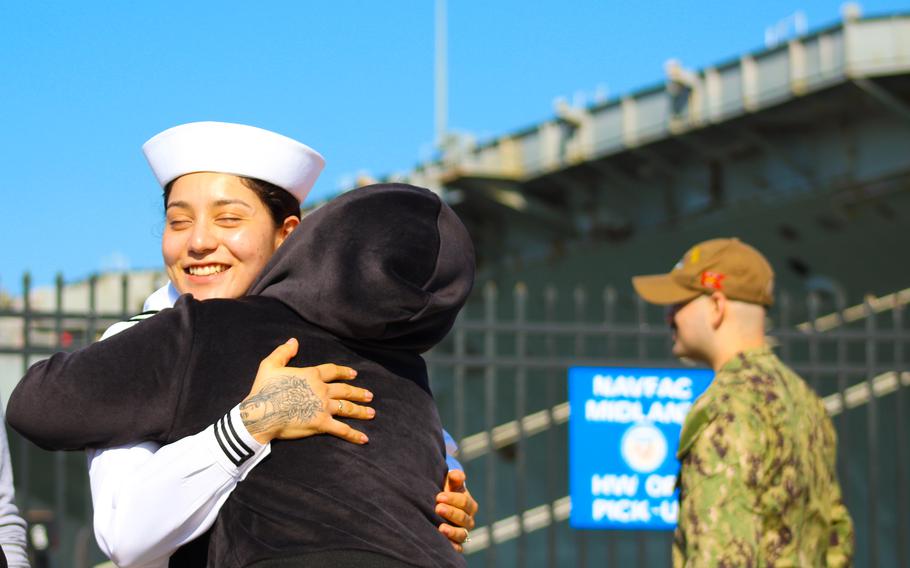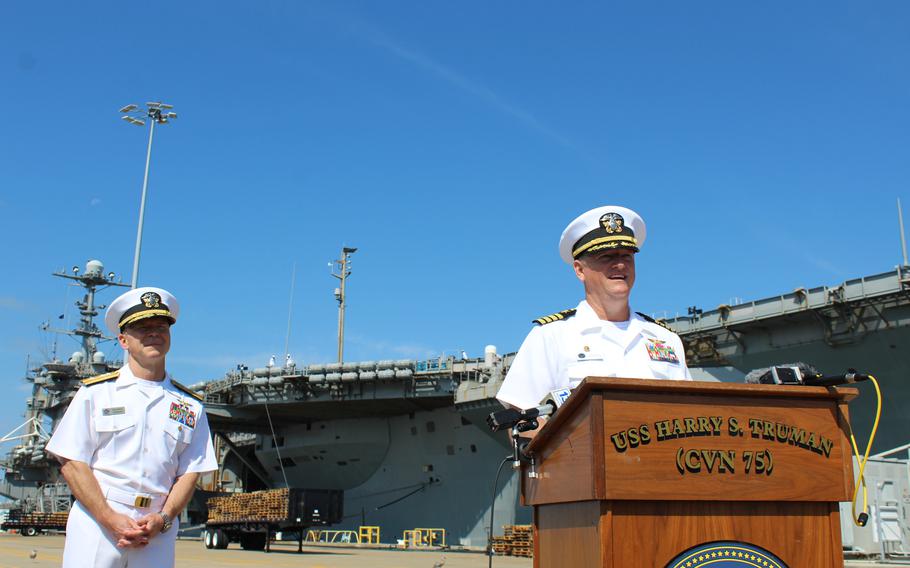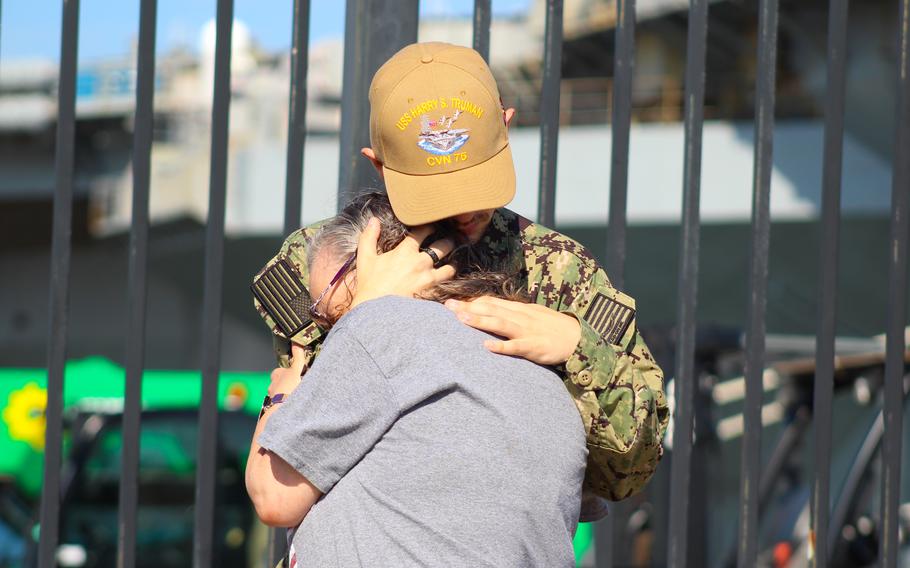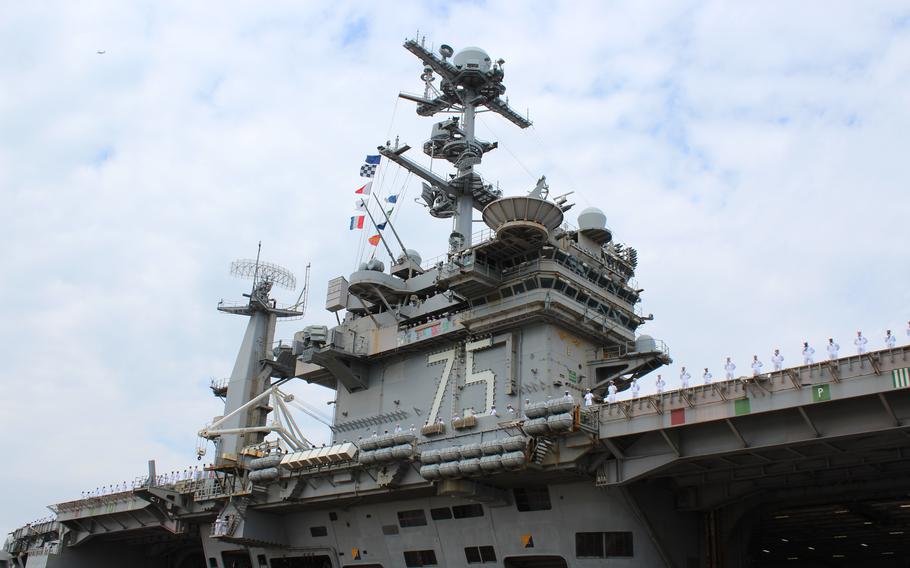.jpg/alternates/LANDSCAPE_910/MoralesBoy%201.jpg)
Hugo Morales waves American flags as the USS Harry S. Truman deploys Monday, Sept. 23, 2024, from Naval Station Norfolk, Va. The Morales family’s sailor, 19-year-old Alexis Morales, is deploying for the first time with the Truman and its strike group. (Caitlyn Burchett/Stars and Stripes)
NORFOLK, Va. — “Just one more!” Cecilia Gamboa shouted, throwing her arms around her daughter, Machinist’s Mate Gianna Rodriguez.
“Seven months is nothing compared to a lifetime,” Rodriguez said, hugging her mother.
Then, after smoothing out her dress whites and saying her final “I love you,” Rodriguez disappeared into a group of sailors making their way down the pier toward the aircraft carrier USS Harry S. Truman.
Dozens of family members and friends gathered Monday at Naval Station Norfolk to wish the crew of the Truman fair winds and following seas ahead of a deployment that is expected to take the warship’s strike group into the Middle East.

Sailor Gianna Rodriguez hugs a family member before climbing aboard the USS Harry S. Truman on Monday, Sept. 23, 2024, at Naval Station Norfolk, Va. (Caitlyn Burchett/Stars and Stripes)
Sailors stoically stood on the flight deck, manning the rails in their dress whites, as the carrier was pushed off the pier. The warship will be joined at sea in the coming days by its strike group, which includes Carrier Air Wing 1 with nine aviation squadrons, guided-missile cruiser USS Gettysburg, and two guided-missile destroyers, the USS Stout and the USS Jason Dunham.
For now, the Truman strike group is deploying to the 6th Fleet area of responsibility, which spans approximately half of the Atlantic Ocean, from the North Pole to Antarctica, as well as the North, Adriatic, Baltic, Barents, Black, Caspian and Mediterranean seas, senior leaders said.
“This crew is ready to answer any call that our nation may have for us to answer,” said Capt. Dave Snowden, commanding officer of the Truman.

Capt. Dave Snowden, commanding officer of the USS Harry S. Truman, and Rear Adm. Sean Bailey, commander of the Truman Carrier Strike Group hold a news conference Monday, Sept. 23, 2024, before the aircraft carrier’s departure from Naval Station Norfolk, Va. (Caitlyn Burchett/Stars and Stripes)
The last time that the Truman deployed was in 2022 to provide air support in response to Russia’s invasion of Ukraine. This time, the warship is potentially deploying for a different kind of battle — drone warfare. The strike group has spent recent months training in the western Atlantic Ocean for a rare, pre-planned deployment expected to take the ship into the hostile environment of the Red Sea.
U.S. sailors and allies have fought almost daily for months to down drones and missiles launched by Iran-backed Houthi rebels in Yemen as tensions in the Middle East have raged on for nearly a year.
“Our world is a dynamic place where threats are emerging everywhere, all across the globe,” said Rear Adm. Sean Bailey, commander of the Truman carrier strike group.
The Truman is deploying with a strike force of 90 aircraft, including F/A-18 Super Hornet fighter jets, E-2D Hawkeye command and control aircraft, E/A18 Growler electronic warfare jets and MH-60 Seahawk helicopters.
The senior commanders said the Truman strike group trained for a broad spectrum of missions but confirmed the group has leveraged lessons learned from other carrier strike groups deployed recently in the region to prepare for a potential Red Sea mission.
“It has not necessarily changed how we focus our training,” Bailey said, referring to the Red Sea. “But what it has done is it’s given us more increased capability against those threats, as they emerge to ensure that we are fully trained to be ready wherever we may go.”
In the past year, Defense Secretary Lloyd Austin has twice ordered two carriers to the region, as well as bolstering U.S. forces with an amphibious ready group and a nuclear-powered submarine.
The aircraft carrier USS Gerald R. Ford, homeported in Virginia, was ordered in October 2023 to sail to the region after a deadly attack on Israel by Hamas militants. The aircraft carrier USS Dwight D. Eisenhower, also East Coast-based, joined the Ford in the winter before the Ford returned to Norfolk. The Eisenhower completed an eight-month deployment to the region in July, being relieved by San Diego-based carrier USS Theodore Roosevelt.
In August, Austin ordered the extension of the Roosevelt as well as directed the USS Abraham Lincoln, also a West Coast-based carrier, to the Red Sea. The Roosevelt’s and the Lincoln’s time in the region overlapped by about three weeks before the Roosevelt was ordered to return home. The Lincoln and its strike group are still there.
“When we deploy, we never know what is going to be in store for us. It is a testament to previous carrier strike groups that were able to quickly pivot to go from one theater to another, go from one mission to another,” Bailey said.
Hours before the ship departed, sailors lingered by the gates of the pier for last-minute goodbyes.

Seaman Mason Baker hugs his mother, Clare Baker, who traveled from North Carolina to see her son off on his first deployment aboard the USS Harry S. Truman on Monday, Sept. 23, 2024, at Naval Station Norfolk, Va.. (Caitlyn Burchett/Stars and Stripes)
Seaman Mason Baker wrapped his mother, Clare Baker, with a hug. She traveled from North Carolina to see her son off on his first deployment. An American flag was emblazoned across her shirt, which read, “My kid has your back.”
Nearby, Gianna Rodiguez’s family stood in the shadow of the ship’s bow a few moments after she said goodbye. They wanted to watch her climb the brow and board the warship. Her mother, father and two sisters traveled from California to see the sailor off on her first deployment.
“She is proud to protect our country. As a mom, my heart is broken because we never want to let go of our children, but we have got to be proud that we raised them well enough. They are doing something big,” Cecilia Gamboa said, wiping tears from her cheeks.
At about midday, the Truman was guided off the pier by tugboats. Dozens of families trickled down the pier, following the ship as far as the pier would allow.
When the ship turned to transit to the Chesapeake Bay and out to sea, a pod of dolphins appeared in the wake of the warship. It will be at least six months before the Truman Carrier Strike Group and its force of 6,500 sailors return home.

The aircraft carrier USS Harry S. Truman and a force of 6,500 sailors deploys Monday, Sept. 23, 2023 on a mission that is expected to take the warship’s strike group into the Middle East. (Caitlyn Burchett/Stars and Stripes)